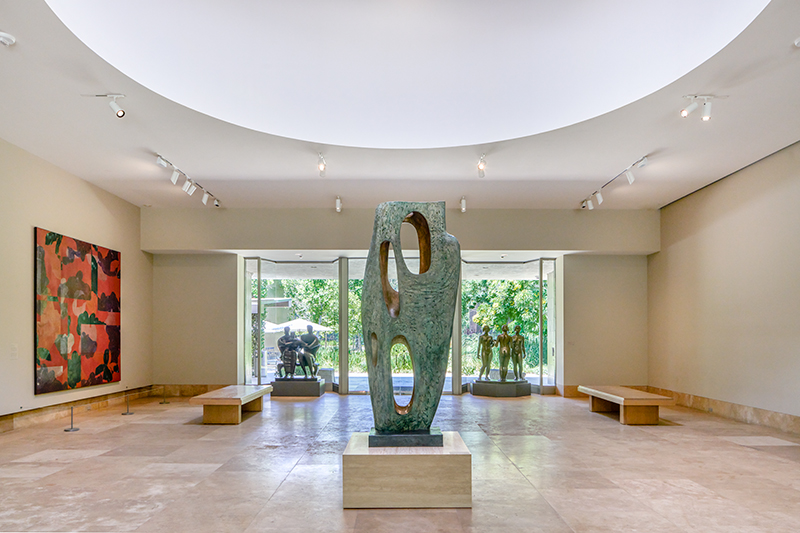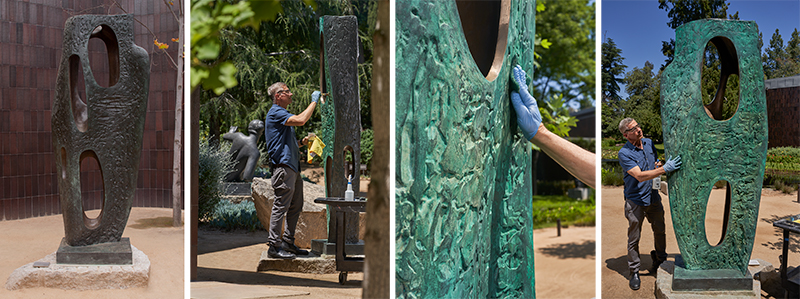Barbara Hepworth’s "Rock Form (Porthcurno)" in the Main Entrance Gallery

Barbara Hepworth (English, 1903–1975), Rock Form (Porthcurno), 1964, bronze, edition of 6, cast no. 3, Norton Simon Art Foundation, © Bowness, Hepworth Estate. Photo by Elon Schoenholz.
After more than two decades in the Museum’s Main Entrance Gallery, where it warmly welcomed visitors, the Norton Simon’s great sandstone sculpture of Buddha Shakyamuni has been relocated to the focus niche off of the stairwell gallery to anchor our new rotating installations of South and Southeast Asian art. In its place, we mounted Barbara Hepworth’s large-scale bronze Rock Form (Porthcurno), which was previously situated in the Sculpture Garden at the far end of the Café. Modeled and cast in 1964, Rock Form (Porthcurno) is one of a series of sculptures that Hepworth began making in the 1960s to explore the creative possibilities of metal. For aesthetic inspiration, she turned to the coastal landscape of Porthcurno, a town in Cornwall, England, near her home and studio. Rock Form (Porthcurno) abstracts and monumentalizes the region’s seaside caves, with their distinctive perforations created by the ebb and flow of the tides.

Left to Right: Rock Form (Porthcurno) before conservation; Head of Conservation and Installations John Griswold at work. Photos by Elon Schoenholz.
As part of the process of bringing the sculpture indoors, we conducted research on the sculpture’s surface appearance and undertook a conservation treatment to help return it to its intended appearance. During its many years of outdoor exposure, Rock Form (Porthcurno) had gradually darkened. The original thin, pale green layer on the rough textured exterior gave way to a uniform dark brown over time. The smooth apertures, originally intended to feature hand-rubbed, golden surfaces, had oxidized to a similarly dark tone. For our treatment, we removed years of protective wax and lacquer, in some areas tinted with added pigments, to reveal some of Hepworth’s surfaces still intact. Bringing the sculpture indoors afforded the opportunity to re-establish the artist’s delicately nuanced veils of color and sheen. With other examples from the same edition of bronzes as an aesthetic guide, as well as treatment precedents set by conservators at the Tate Modern and Tate St. Ives, home of Hepworth’s studio, the openings were carefully repolished and coated with clear lacquer. The lighter greens of the textured surface were re-established with a combination of inpainting and chemical repatination.
For Hepworth, Rock Form (Porthcurno) and related bronzes represent the innate connection between people and the natural environment. “They were experiences of people,” she said of these works; “the movement of people in and out is always a part of them.” In its new location, Rock Form (Porthcurno) embodies much of what the artist envisioned for the sculpture. Surrounded by the ebb and flow of visitors, it marks the threshold where land and water meet, offering a peek at the pond beyond the Entrance Gallery through its newly gleaming apertures.
Emily Talbot, Chief Curator, and John Griswold, Head of Conservation and Installations
This article first appeared in the Museum’s Fall 2023 Newsletter.
